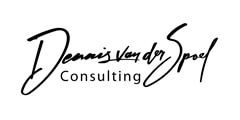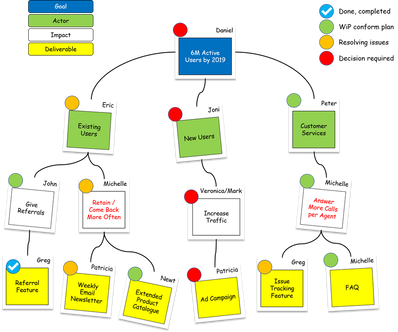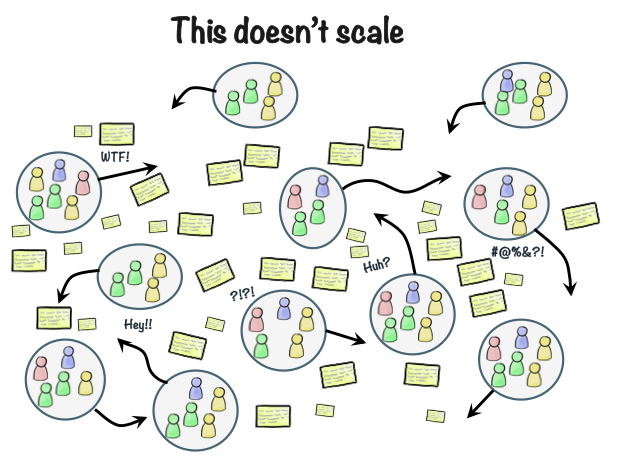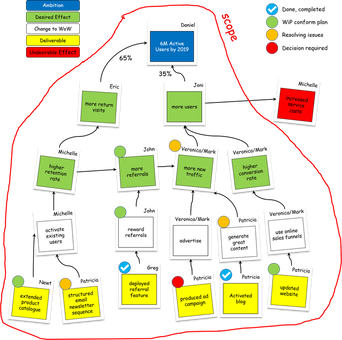|
By: Dennis van der Spoel Our products and initiatives do not work in a vacuum. They have an interdependent, dynamic relationship with people, other projects, the organization and the wider community around them. Yet most planning methods either expect the world to stand still while we deliver (Waterfall) or that we give up on creating any kind of long-term big-picture view (Agile), leaving a huge communication gap between business sponsors and delivery teams. Impact maps visualize the dynamic relationship between delivery plans and the world around them, capturing the most important assumptions as well as delivery scope. They help us adapt plans effectively and react to change, while still providing a good road map for delivery teams and a big-picture view for business sponsors. The Issues with Portfolio ManagementWhether you are using a silo or a value stream approach to portfolio management, strategic alignment remains a major challenge. In the silo-oriented project portfolio management-approach, this is often due to segmentation of budgets and accountabilities. In lean-agile product/project portfolio management this is due to the focus on the short-term value of initiatives. In both cases, impact mapping offers a solution. In silo-based portfolio management, impact mapping helps to align and prioritize all initiatives across the silos. In lean-agile portfolio management, impact mapping helps to discover and communicate the longer-term business value of potential epics. If you would like to learn more about the issues with portfolio management, you might be interested in benefit mapping as well.
1 Comment
By: Dennis van der Spoel
Any company working with more than, say, 80 people on the development of a single product or solution will not manage with just Scrum as a guideline for an agile way of working. Fortunately, several frameworks have been developed to make agile ideas workable in larger companies. Sometimes small concessions have been made to the autonomy of individuals and teams for the sake of coordination. This has led to discussions about what is still agile and which framework should no longer be allowed to wear that predicate. The framework that is most popular and also the most under fire is the Scaled Agile Framework® (SAFe). Is that rightly so?
If we look at frameworks such as Nexus, LeSS and especially SAFe, the criticism mainly focuses on the alleged lack of space for people to find their own way of working and the alleged lack of simplicity. Those frameworks have caused this themselves. For example, the SAFe Reference Guide consists of 800 pages, where Scrum fits on just 17 pages. At first glance, therefore, SAFe seems 40 times more complex than Scrum. But that is not the whole story. It is precisely the lack of 'guidance' that inhibits the adoption of Scrum (and therefore agile) within larger organizations. Scrum does not offer a solution for every context. The idea is that Scrum teams themselves discover an optimal way of working. That works well with a single team. With two or three teams that is often fine too. However, once you really start scaling, cooperation between teams no longer comes naturally. Consultants and coaches, as yours truly, build their entire business model on this issue. But that is not sustainable. Forgive me for the detour that I am about to make in my reasoning. At the end of this article I will come back to the criticism of the most important agile frameworks in general and SAFe in particular. By: Dennis van der Spoel Whether you are using a silo or a value stream approach to portfolio management, strategic alignment remains a major challenge. In the silo-oriented project portfolio management-approach, this is often due to segmentation of budgets and accountabilities. In lean-agile product / project portfolio management this is due to the focus on the short-term value of initiatives. In both cases, benefit mapping offers a solution. In silo-based portfolio management, benefit mapping helps to align and prioritize all initiatives across the silos. In lean-agile portfolio management, benefit mapping helps to discover and communicate the near-term business value of potential epics. The Issues with Portfolio Management when Funding SilosEvery fall the ceremonies to define the organizational and departmental budgets for next year are the same. Each cost-center creates a spreadsheet of their forecast of next year’s income and expenses. Usually, these include revenues, wages, overhead, IT, and training. About 80 percent of the expenses is earmarked for business as usual. About 20 percent is reserved for planned change initiatives. And the total budget should preferably be within a 5 percent deviation from last year’s budget to avoid intense debate.
|
Archives
August 2020
Index
All
|
Services |
Company |
|




 RSS Feed
RSS Feed